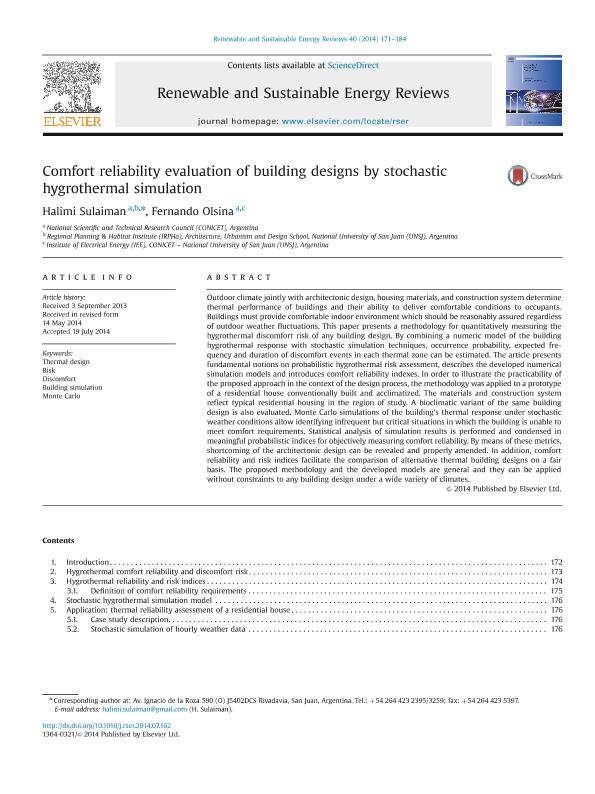Mostrar el registro sencillo del ítem
dc.contributor.author
Sulaiman, Halimi Cristina

dc.contributor.author
Olsina, Fernando Gabriel

dc.date.available
2018-02-26T21:36:25Z
dc.date.issued
2014-12
dc.identifier.citation
Sulaiman, Halimi Cristina; Olsina, Fernando Gabriel; Comfort reliability evaluation of building designs by stochastic hygrothermal simulation; Pergamon-Elsevier Science Ltd.; Renewable & Sustainable Energy Reviews; 40; 12-2014; 171-184
dc.identifier.issn
1364-0321
dc.identifier.uri
http://hdl.handle.net/11336/37199
dc.description.abstract
Outdoor climate jointly with architectonic design, housing materials, and construction system determine thermal performance of buildings and their ability to deliver comfortable conditions to occupants. Buildings must provide comfortable indoor environment which should be reasonably assured regardless of outdoor weather fluctuations. This paper presents a methodology for quantitatively measuring the hygrothermal discomfort risk of any building design. By combining a numeric model of the building hygrothermal response with stochastic simulation techniques, occurrence probability, expected frequency and duration of discomfort events in each thermal zone can be estimated. The article presents fundamental notions on probabilistic hygrothermal risk assessment, describes the developed numerical simulation models and introduces comfort reliability indexes. In order to illustrate the practicability of the proposed approach in the context of the design process, the methodology was applied to a prototype of a residential house conventionally built and acclimatized. The materials and construction system reflect typical residential housing in the region of study. A bioclimatic variant of the same building design is also evaluated. Monte Carlo simulations of the building's thermal response under stochastic weather conditions allow identifying infrequent but critical situations in which the building is unable to meet comfort requirements. Statistical analysis of simulation results is performed and condensed in meaningful probabilistic indices for objectively measuring comfort reliability. By means of these metrics, shortcoming of the architectonic design can be revealed and properly amended. In addition, comfort reliability and risk indices facilitate the comparison of alternative thermal building designs on a fair basis. The proposed methodology and the developed models are general and they can be applied without constraints to any building design under a wide variety of climates.©2014 Published by Elsevier Ltd.
dc.format
application/pdf
dc.language.iso
eng
dc.publisher
Pergamon-Elsevier Science Ltd.

dc.rights
info:eu-repo/semantics/openAccess
dc.rights.uri
https://creativecommons.org/licenses/by-nc-nd/2.5/ar/
dc.subject
Building Simulation
dc.subject
Discomfort
dc.subject
Monte Carlo
dc.subject
Risk
dc.subject
Thermal Design
dc.subject.classification
Otras Ingeniería Civil

dc.subject.classification
Ingeniería Civil

dc.subject.classification
INGENIERÍAS Y TECNOLOGÍAS

dc.subject.classification
Ingeniería Mecánica

dc.subject.classification
Ingeniería Mecánica

dc.subject.classification
INGENIERÍAS Y TECNOLOGÍAS

dc.subject.classification
Matemática Pura

dc.subject.classification
Matemáticas

dc.subject.classification
CIENCIAS NATURALES Y EXACTAS

dc.title
Comfort reliability evaluation of building designs by stochastic hygrothermal simulation
dc.type
info:eu-repo/semantics/article
dc.type
info:ar-repo/semantics/artículo
dc.type
info:eu-repo/semantics/publishedVersion
dc.date.updated
2018-02-26T15:07:26Z
dc.journal.volume
40
dc.journal.pagination
171-184
dc.journal.pais
Estados Unidos

dc.journal.ciudad
Amsterdam
dc.description.fil
Fil: Sulaiman, Halimi Cristina. Universidad Nacional de San Juan. Facultad de Arquitectura, Urbanismo y Diseño. Instituto Regional de Planeamiento y Habitat; Argentina. Consejo Nacional de Investigaciones Científicas y Técnicas; Argentina
dc.description.fil
Fil: Olsina, Fernando Gabriel. Universidad Nacional de San Juan. Facultad de Ingeniería. Instituto de Energía Eléctrica; Argentina. Consejo Nacional de Investigaciones Científicas y Técnicas; Argentina
dc.journal.title
Renewable & Sustainable Energy Reviews

dc.relation.alternativeid
info:eu-repo/semantics/altIdentifier/doi/http://dx.doi.org/10.1016/j.rser.2014.07.162
dc.relation.alternativeid
info:eu-repo/semantics/altIdentifier/url/https://www.sciencedirect.com/science/article/pii/S1364032114006145
Archivos asociados
